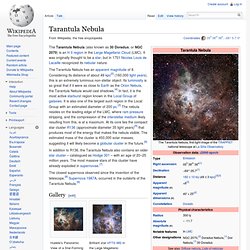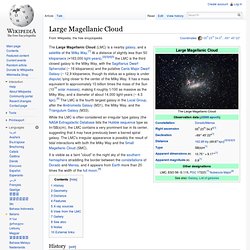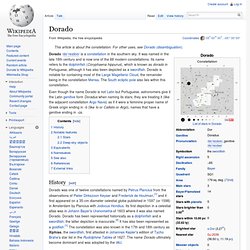

Tarantula Nebula. The brilliant stars in the Tarantula Nebula are unleashing a torrent of ultraviolet light and hurricane-force stellar winds that are etching away at the hydrogen gas cloud in which the stars were born.

The Tarantula Nebula (also known as 30 Doradus, or NGC 2070) is an H II region in the Large Magellanic Cloud (LMC). It was originally thought to be a star, but in 1751 Nicolas Louis de Lacaille recognized its nebular nature. In addition to R136, the Tarantula Nebula also contains an older star cluster – catalogued as Hodge 301 – with an age of 20–25 million years. The most massive stars of this cluster have already exploded in supernovae.[7] The closest supernova observed since the invention of the telescope,[8] Supernova 1987A, occurred in the outskirts of the Tarantula Nebula.[9] Gallery[edit] Brilliant star VFTS 682 in the Large Magellanic Cloud. The young cluster RMC 136a Coordinates: 05h 38m 38s, −69° 5.7′ 0″ References[edit] ^ Jump up to: a b c d "SIMBAD Astronomical Database". Large Magellanic Cloud. The Large Magellanic Cloud (LMC) is a nearby galaxy, and a satellite of the Milky Way.[7] At a distance of slightly less than 50 kiloparsecs (≈163,000 light-years),[2][3][4][5] the LMC is the third closest galaxy to the Milky Way, with the Sagittarius Dwarf Spheroidal (~ 16 kiloparsecs) and the putative Canis Major Dwarf Galaxy (~ 12.9 kiloparsecs, though its status as a galaxy is under dispute) lying closer to the center of the Milky Way.

It has a mass equivalent to approximately 10 billion times the mass of the Sun (1010 solar masses), making it roughly 1/100 as massive as the Milky Way, and a diameter of about 14,000 light-years (~ 4.3 kpc).[8] The LMC is the fourth largest galaxy in the Local Group, after the Andromeda Galaxy (M31), the Milky Way, and the Triangulum Galaxy (M33). History[edit] Small part of the Large Magellanic Cloud[10] The next recorded observation was in 1503–4 by Amerigo Vespucci in a letter about his third voyage. Geometry[edit] Distance[edit] Features[edit] Dorado_IAU. Dorado. Even though the name Dorado is not Latin but Portuguese, astronomers give it the Latin genitive form Doradus when naming its stars; they are treating it (like the adjacent constellation Argo Navis) as if it were a feminine proper name of Greek origin ending in -ō (like Io or Callisto or Argo), names that have a genitive ending in -ūs.

History[edit] Dorado was one of twelve constellations named by Petrus Plancius from the observations of Pieter Dirkszoon Keyser and Frederick de Houtman, and it first appeared on a 35-cm diameter celestial globe published in 1597 (or 1598) in Amsterdam by Plancius with Jodocus Hondius. Its first depiction in a celestial atlas was in Johann Bayer's Uranometria of 1603 where it was also named Dorado.
Dorado has been represented historically as a dolphinfish and a swordfish; the latter depiction is inaccurate. It has also been represented as a goldfish. Notable features[edit] The constellation Dorado as it can be seen by the naked eye. Stars[edit] Namesakes[edit] Dorado, Mensa.